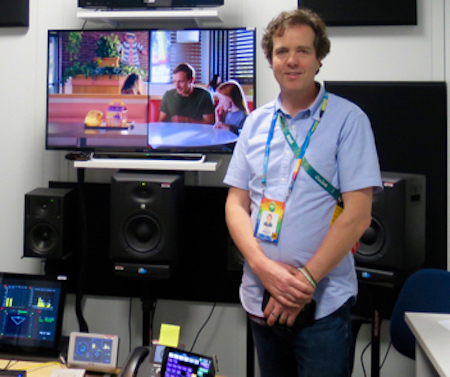NBCUniversal’s Karl Malone Sees Immersive Sound Transforming Olympics Audio
The result is a hyper-realistic experience for viewers at home
On the podcast “Transformed by Tech: How the Olympics Stay Cutting Edge,” produced by The Podium for NBC Olympics, Karl Malone, director, sound design, NBCUniversal, discussed how the Tokyo Olympics’ sound will be collected, produced and processed, transported, and ultimately consumed by the broadcast audience for the. Here are some highlights of that podcast.
Immersive sound will be a hallmark of this Olympiad, and Malone said this new approach to audio is developing its own sense of sound design both to introduce some viewers to an unfamiliar sport and to convey nuance to aficionados.

NBCUniversal’s Karl Malone: “The idea with sound design is that you try to bring that into the home and make it appreciated by people who may not know the sport.”
“There are a lot of different types of audio that we are involved in at the moment,” he explained. “You do surround sound, and you do immersive audio, and you put a lot of things either behind you or even sometimes above you. But the idea with sound design is that you try to bring that into the home and make it appreciated by people who may not know the sport.”
Asked about how placing microphones ever closer to athletes transforms the broadcast-sports experience and how that audio is transported to the viewer coherently, Malone replied, “We’re always trying to tell the story, but we’re also always trying to give the listener the best seat in the house. For the Olympics, we have a lot of smaller mics and radio mics and even shotgun mics to enable us to capture audio from a long way away. We have a lot of smaller RF microphones, many [of which] are hidden: we’ve got microphones in the ground, underwater mics, mics underneath the ice, on people’s clothes. We’ve made things so [transparent] to the athlete that they don’t realize [the microphones] are there. We do work with microphone manufacturers, and they have developed specific microphones for sports like diving, basically picking up the vibrations of the water on the mic. We have hundreds of mics. [For] diving, I would say, we now have 20 microphones on the diving board alone.”
(According to the Olympics Broadcast Services guide, a total of 3,600 microphones will be deployed throughout the Olympics campus, and NBC Sports will deploy many of its own mics for its broadcasts.)
Hyper-Real Audio
The audio coverage has reached the point, Malone suggested, where the viewer can enjoy a hyper-realistic experience: “The athlete can hear the arrow leave the bow, but the people at home can hear that arrow fly through the air all the way until it hits the target, because we have microphones buried in the ground in a line the whole way to the target. The idea with sound design is, we try to bring that into the home and make it appreciated by people who may or may not know the sport. If you are a skier and you’re watching downhill skiing at home on the couch, we want to convey what the conditions are like.
“For the Olympics,” he continued, “the most important thing about the sound coming out of the starting gun is, first, that it is in sync. You’ve got to capture that sound immediately: as soon as you see the flash of light from the gun, you need to hear the gunshot. So the capture is everything, and … the microphone capturing that audio is the most important part.
“And then it may travel to a remote TV truck that’s in the venue,” he added, “and, from the truck, it’s mixed and usually sent to the International Broadcast Center, where all the world’s broadcasters will have their technical facilities. We’ll take that gunshot through the truck, back to the IBC where there could be another control room that could be the primetime control room for NBC. From there, that mix will be married to the video, and I think it takes about six different backup paths to the U.S., including undersea paths. From one of those six paths from the IBC, it will end up normally in Denver, in Dry Creek at our master control. That will basically put that gunshot, in that primetime show, straight to air.”
Sweetened Sound
As realistic as the Olympics’ audio will be, it will still occasionally require a bit of a cinematic boost to maintain the continuity and consistency of a sports narrative.
“Sometimes, we need to sweeten the sound,” Malone acknowledged. “For example, in rowing, it’s very difficult for us to get the sound of the oars in the water. So it’s not unknown for us to have a track of the oars … in the water, which you can hear when the crew is pulling in the water, along with the coxswain giving orders and maybe the coach as well on the bike path. But, to get the sound of the oars going through the water, a lot of times, we’ll have to Foley that [add manually recorded sound effects] because it’s just not possible due to the amount of noise and creaking and things like that in a boat. But these are things that you would never notice, [unless] you knew about them.”
Proclaiming “the biggest media event ever,” NBC Sports plans to present 7,000 hours of Tokyo Olympics coverage on two broadcast networks, six cable networks, and multiple digital platforms, serving both English- and Spanish-language viewers. For the first time ever, the NBC broadcast network’s Olympics primetime show in certain markets will be offered in 4K UHD and High Dynamic Range (HDR) with Dolby Atmos sound. NBC’s primetime coverage of the Opening and Closing Ceremonies will also be presented in 4K HDR.
